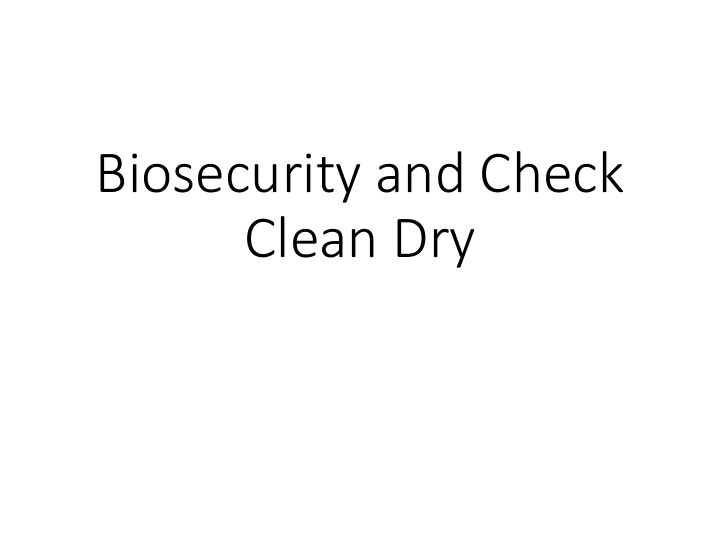



Biosecurity and Check Clean Dry
What is biosecurity? • Good hygiene practices to reduce the risk of spreading invasive non-native species, disease, etc • Always essential, even if invasive non-native species are not always apparent
Why is it a good idea? Which of these actions has the potential to be most harmful to the environment? • Throwing away 20 litres of paint by pouring it down a drain • Disposing of an unusual plant from your garden pond by throwing it into a river • Dumping an old fridge in a layby
Why is it a good idea? Which of these actions has the potential to be most harmful to the environment? • Throwing away 20 litres of paint by pouring it down a drain • Disposing of an unusual plant from your garden pond by throwing it into a river • Dumping an old fridge in a layby
Floating pennywort • Grows from very small fragments • Many INNS can survive out of water, on damp equipment or clothing for two weeks
Floating pennywort • Grows from very small fragments • Spreads rapidly in slow-flowing, lowland waterways
Floating pennywort • Forms dense carpets across water and mud • Gives the impression of a safe surface
Floating pennywort • Huge issue for navigation and angling • In 2010 the annual cost of pennywort (including management and tourism impacts) to Britain estimated at over £25 million
Basic ic Bio iosecurity Advice when working in in the fi field • Arrive at the site with clean footwear and vehicle. • Ensure footwear is clean (visually from soil and debris) before leaving the site. • Ensure vehicle is kept clean - in particular remove any accumulated mud before leaving the site. • Make use of facilities provided on the site to clean footwear/equipment. • Keep access to a minimum. • If practical do not take vehicles onto premises, keep to established tracks and park vehicles on hard standing. • Where possible avoid areas of livestock and areas with known plant disease. • Plan visits so that the most risky visit is the last one of the day.
Check Clean Dry Based on similar campaign in NZ Partnership campaign between government and environmental NGOs Guidance for recreational water users Launched March 2011, updated 2017
Impact of campaign - 2018 Public Awareness Survey Anglers • 61% wash equipment every time (increase from 44% in 2008) • 87% aware of “INNS” (78% in 2008) • Significantly higher than general public (67%)
Impact of campaign - 2018 Public Awareness Survey Boaters • 49% wash boat and equipment every time • 83% aware of “INNS” • Significantly higher than general public (67%)
2018 Public Awareness Survey Encouraging but still a long way to go Impact in NZ Invasive pest Didymo discovered in South Island in 2004 North Island kept free
Campaign updated in 2018 Focus groups with recreational water users Feedback from key partners Bespoke materials
Free materials available • Signs for entrance / exit to waterbodies • Posters • Leaflets • Waterproof stickers • Pop up banners Bespoke versions for: • Game anglers • Marine anglers • Coarse anglers • Boaters • Marine boaters • Canal boaters • Canoeists / kayakers
Annual border biosecurity campaign Six months
Annual border biosecurity campaign Six months
Practical biosecurity at events
Pathway Action Plans GB Strategy Key Action 3.3 Priority pathways
Pathway Action Plans Two in development: • Angling – complete • Boating – expected early 2020
Pathway Action Plans Aims: Reduce risk of introduction and spread of INNS based on international good practice Series of key actions for different stakeholders
Pathway Action Plans Raising awareness of NNS issues Increasing uptake of biosecurity Building on existing work including Check Clean Dry
Invasive Species Week 2020 • 18-22 May 2020 • Focus on threat to biodiversity in Britain from invasive species • Future threats – new species from abroad, impact of climate change • Current threats – established species • Encouraging people to take part in volunteering • Lots of ways to take part, visit www.nonnativespecies.org/invasivespeciesweek
Biosecurity and Check Clean Dry What does success look like? • Everybody is aware of INNS • Check Clean Dry messages on displayed in relevant locations • Wash-down facilities available at key locations • Washing equipment every time is second nature • Spread of INNS is prevented or reduced
Recommend
More recommend